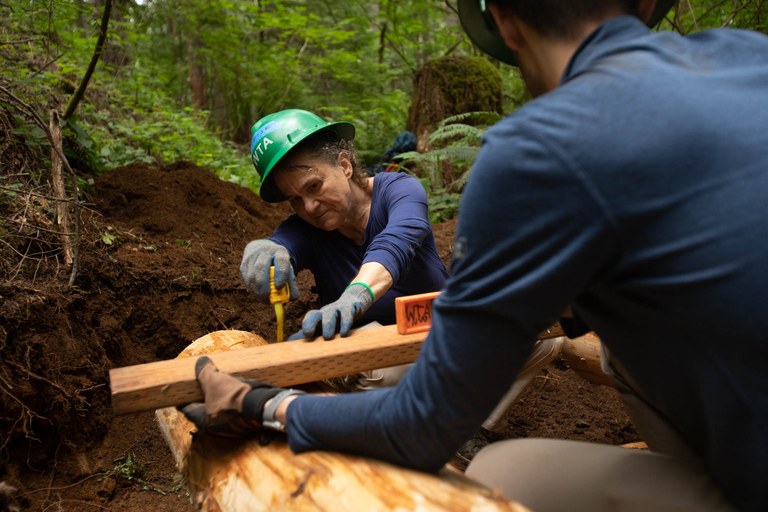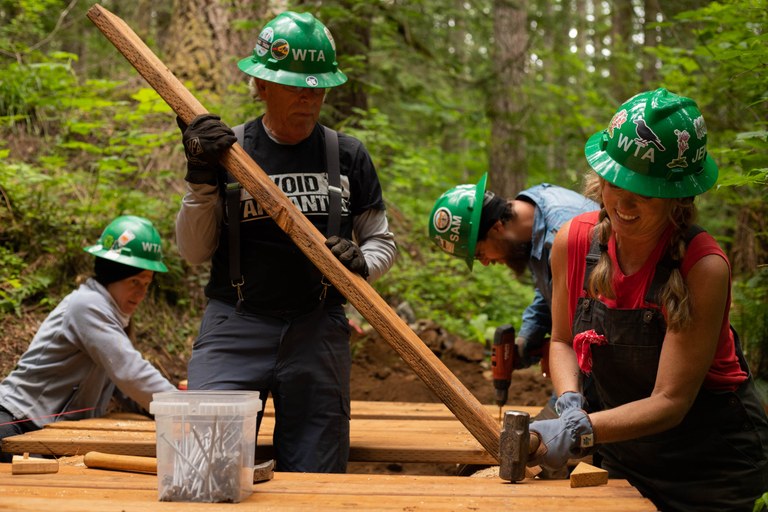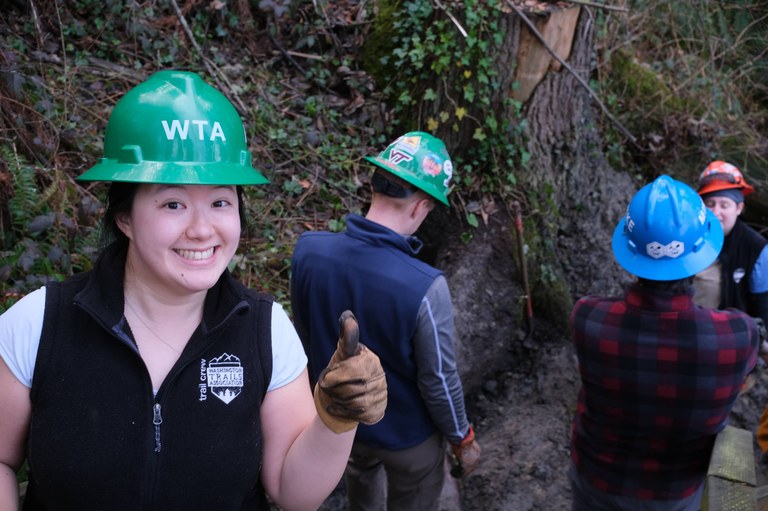 Washington Trails
Association
Washington Trails
Association
Trails for everyone, forever
If you’ve ever joined a WTA work party, you know the work is about more than digging tread or clearing brush. By Brandon Tigner
It’s about people — volunteers from all walks of life — coming together to build something greater than what any one person could do alone.
And sometimes, quite literally, it’s about putting our heads together.
Take a look at the photo above. Two greenhats crouched over a timber, deep in conversation. They were trying to figure out a tricky carpentry cut for a trail structure. No blueprint. No supervisor stepping in with a solution. Just two minds working side by side, measuring angles, checking their math and sketching out ideas in the dirt.
This wasn’t a moment of instruction. It was a moment of collaboration. It was two volunteers taking the skills they'd learned on trail work parties and putting them to use. And it’s the kind of thing I get to witness on nearly every work party I attend.
What makes WTA special is that we don’t just assign tasks. We offer opportunities. Volunteers aren’t passive helpers, they’re active participants. Every crew member has the chance to think critically, ask questions and offer input.
That’s especially true for newer volunteers. We often talk about learning by doing. On WTA work parties, that means trusting people to take ownership of the work, even if they’re still getting the hang of it. It means a crew leader asking, “What do you think we should do here?” and genuinely meaning it.
I’ve seen folks with no previous experience solve trail drainage puzzles with creative solutions. I’ve watched high schoolers confidently lead the charge on rock placement. And I’ve seen seasoned volunteers step back, not because they’re checking out, but because they want to create space for others to step up.

Volunteers work on installing deck boards on a brand new bridge at Wallace Falls State Park. Photo by Kesia “Lee” Lee.
Trail building is inherently collaborative. Whether it’s lifting a log, rerouting a trail or setting a string line to guide construction on a puncheon, nothing gets done alone. But beyond the physical work, there’s a deeper kind of collaboration at play, one rooted in shared curiosity and mutual respect.
Sometimes it’s the little things:
I’ve seen all of these moments, and so many more on trail. This kind of environment fosters more than strong trails. It fosters growth. I see people discover their confidence. You see leaders emerge naturally. And you see that spark when a volunteer realizes I’m not just helping. I’m contributing.

Volunteers work together to attach the last few deck boards to complete the bridge. Photo by Kesia “Lee” Lee.
The beauty of this approach is that it creates a feedback loop. Empowered volunteers bring more energy, more ideas and more joy to the work. That leads to better-built structures, more sustainable tread and, just as importantly, stronger community.
I once watched a group of volunteers troubleshoot the final alignment on a new section of trail. Instead of just waiting for the crew leader to decide, they walked the route together, debated options and weighed the impact of each tweak. When they finally landed on the right line, the whole crew was buzzing. They owned that decision. And that trail segment is still holding up beautifully.

Finished Trail section at Loganberry Lane. Photo by Brandon Tigner.
At its core, trail work is problem-solving in the wild. No two sites are the same, and no single solution works everywhere. That’s why collaboration isn’t just a nice-to-have, it’s essential.
Sometimes the best way forward comes from someone with fresh eyes. Sometimes it comes from someone with years of experience. But more often than not, it comes from two people putting their heads together, just like those greenhats in the photo, and asking, “What if we tried this?”

A happy volunteer working on installing new steps at Kayak Point Regional Park. Photo by Jack Hsu.
Whether you’re new to trail work or a seasoned log-out pro, your perspective matters. Your questions matter. Your presence matters.
Come out for a day and you’ll see for yourself. The best trails are built not just with tools and muscle, but with ideas, teamwork and shared purpose.
Join a WTA work party today and bring your thinking cap.